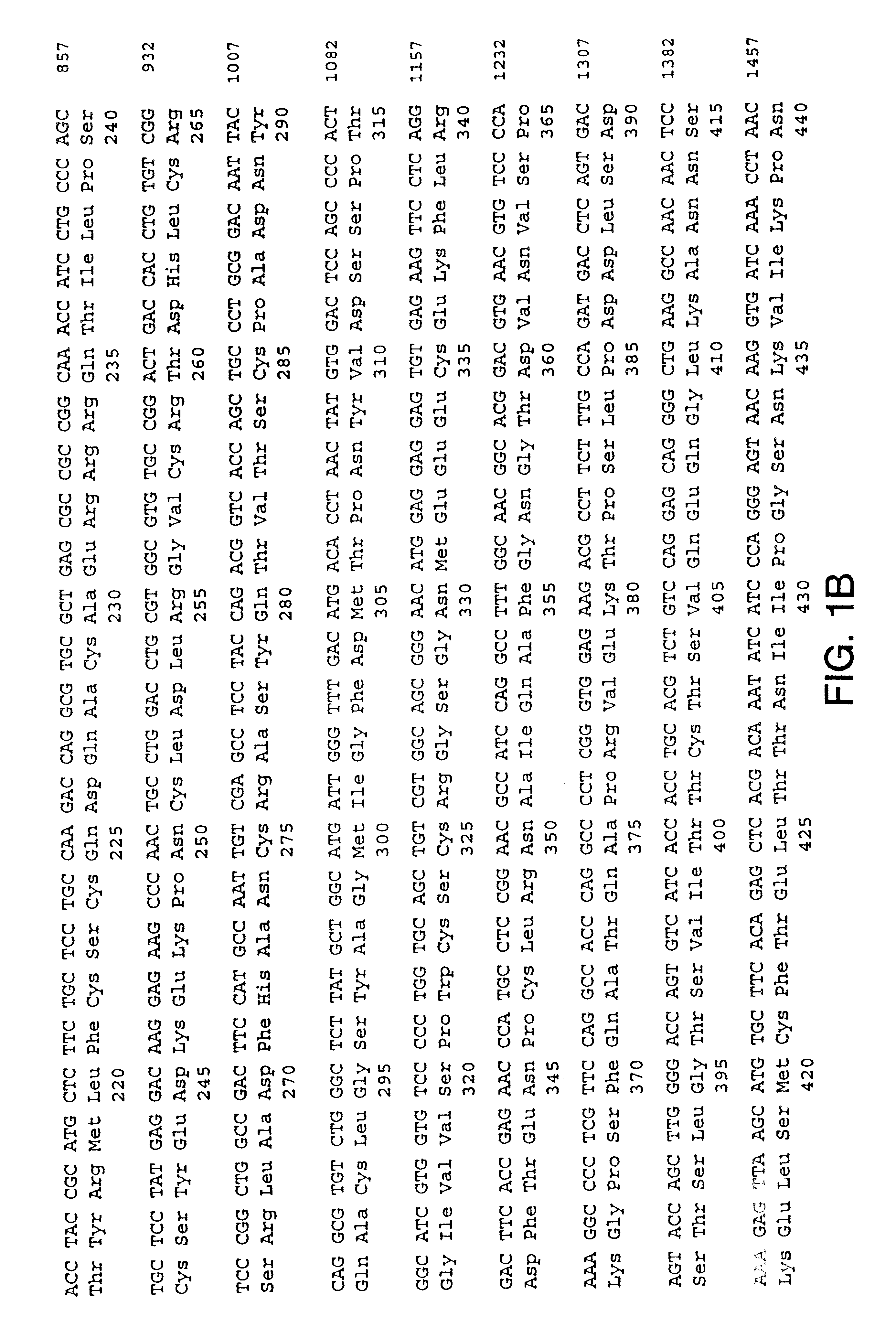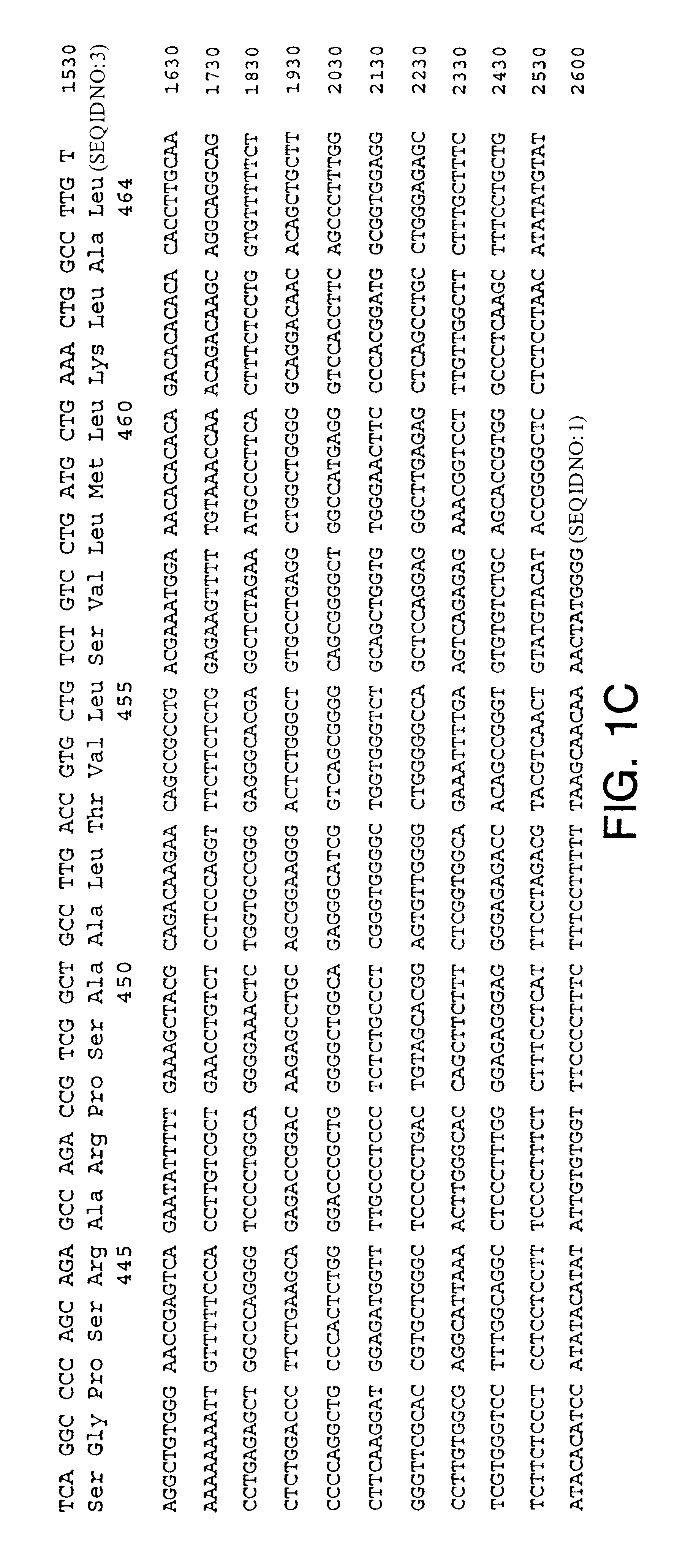Neurturin receptor
a receptor and neuroturbin technology, applied in the field of neuroturbin (" ntn ") receptors, can solve the problems of different malignancies and pathological disorders, the recovery of genomic dna encoding ntnr.alpha. is more complex than that of an exogenous state, and the effector function does not includ
- Summary
- Abstract
- Description
- Claims
- Application Information
AI Technical Summary
Problems solved by technology
Method used
Image
Examples
example 1
Cloning of Human NTNR.alpha.
Eight partial human cDNAs (Genbank accession numbers: R02249 (SEQ ID NO.: 7), H12981 (SEQ ID NO.: 8), W73681 (SEQ ID NO.: 9), W73633 (SEQ ID NO.: 10), H05619 (SEQ ID NO.: 11), R02135 (SEQ ID NO.: 12), T03342 (SEQ ID NO.: 13), and HSC1KA 11 (SEQ ID NO.: 14)) were identified as having similarity to the GDNF receptor .alpha. component (Jing et al. Cell 85:1113-1124 (1996); Treanor et al. Nature 382:80-83 (1996)), but were not identical to GDNFR sequences. A DNA sequence, determined by aligning these expressed-sequence-tag ("EST") cDNA sequences, was extended using 5' and 3' Marathon RACE reactions (Clonetech Inc.) on human spleen mRNA, using conditions supplied by the manufacturer, to obtain an initial set of human cDNA clones. Additional cDNA clones were identified by screening a human fetal brain cDNA library (Stratagene) using standard protocols. Lambda cDNA libraries were plated using standard protocols and a coding region probe, obtained by PCR amplific...
example 2
Cloning of Rat NTNR.alpha. ("rNTNR.alpha.")
Rat NTNR.alpha. ("rNTNR.alpha.") was cloned by screening a rat brain cDNA library (Clonetech) using standard protocols. A full-length human NTNR.alpha. probe was hybridized to the rat cDN library at moderate stringency (e.g., 30% formamide at 42.degree. C., wash in 0.1.times.SSC at 55.degree. C.). The cDNA, having (SEQ ID NO: 4) and containing the complete open reading frame (SEQ ID NO: 5), was designated as rNTNR.alpha. cDNA. The open reading frame sequence encoded a single 464 amino acid protein sequence (SEQ ID NO: 6), which was designated rat Neurturin receptor a ("rNTNR.alpha.").
Rat NTNR.alpha. and human NTNR.alpha. display an overall 94% similarity at the amino acid level. At the DNA level, a 79% identity was observed. Rat NTNR.alpha. is 46% identical to both rat GDNFR.alpha. and human GDNFR.alpha. at the protein level. Rat NTNR.alpha. is 53% identical to rat GDNFR.alpha. at the DNA level.
rNTNR.alpha., like rGDFR.alpha., hGDNFR.alpha....
example 3
Vectors for Expression of Membrane-Bound and Soluble NTNR.alpha.
For mammalian protein expression the complete open reading frame of human NTNR.alpha. was amplified using PCR and cloned into a CMV based expression vector pRK5 or pRK7. The plasmid was designated pRK-hNTNR.alpha. for the human NTNR.
To make soluble forms of rat and human NTNR.alpha., both rat and human NTNR.alpha.-IgG expression constructs were made by cloning the first 432 amino acids of each receptor (which lacks a GPI linkage site) in front of the human Fc sequence. For example, the NTNR.alpha.-IgG expression construct was made by cloning the first 432 amino acids of the receptor (which lacks a GPI linkage site) in front of the human Fc (IfF2a) sequence. Plasmids were designated pRK-hNTNR.alpha.-IgG for hNTNR.alpha. fusion an pRK-rNTNR.alpha.-IgG for rat NTNR.alpha. fusion. The human gene fusion coding nucleic acid sequence is SEQ ID NO: 15, which encodes the human fusion protein SEQ ID NO: 16. Suitable locations for...
PUM
| Property | Measurement | Unit |
|---|---|---|
| Fraction | aaaaa | aaaaa |
| Molar density | aaaaa | aaaaa |
| Solubility (mass) | aaaaa | aaaaa |
Abstract
Description
Claims
Application Information
 Login to View More
Login to View More - R&D
- Intellectual Property
- Life Sciences
- Materials
- Tech Scout
- Unparalleled Data Quality
- Higher Quality Content
- 60% Fewer Hallucinations
Browse by: Latest US Patents, China's latest patents, Technical Efficacy Thesaurus, Application Domain, Technology Topic, Popular Technical Reports.
© 2025 PatSnap. All rights reserved.Legal|Privacy policy|Modern Slavery Act Transparency Statement|Sitemap|About US| Contact US: help@patsnap.com



